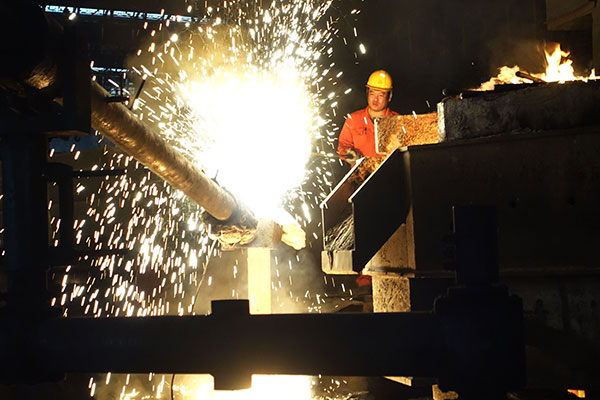 |
|
Workers at a steel factory in Dalian, Liaoning province. [Photo/China Daily] |
The government is determined to rejuvenate the northeastern region. And to achieve its goal, the government has to focus on the reform of State-owned enterprises, because that is the key to the economic transformation of lackluster old industrial bases.
The reform of SOEs, which comprise a large proportion of the State sector, is closely related to the region's structural adjustments, economic transformation and upgrading, especially when it comes to the relationship between the government and the market.
Since SOEs account for a large part of the Northeast China's manufacturing sector, the region's revival is impossible without the revival of the manufacturing sector. So the transformation and upgrading of the sector has to be expedited.
The problem of the unitary industrial structure remains very prominent in the region and is one of the reasons of the nationwide industrial overcapacity. Therefore, the problem has to be solved before it causes further damage to the manufacturing sector.
During the 13th Five-Year Plan (2016-20) period, whether the region will gain from the new "technological revolution" and rising nationwide consumption will depend on whether it can transform the State-owned sector's production-based economy to services-oriented manufacturing. In 2014, production-based manufacturing accounted for 35 percent to 40 percent of the entire service sector in the region's three provinces of Heilongjiang, Jilin and Liaoning, 5 to 10 percentage points less than the country's average. If the three provinces can promote their production-based services by reforming the SOEs, they can more expeditiously transform and upgrade their broad manufacturing sector.
To accelerate the region's rejuvenation, the proportion of State-owned capital in the region's economy has to be lowered. In 2014, SOEs owned about 50 percent of the total assets of all industrial enterprises above a certain level, compared with the country's average of about 10 percent. This has not only made it difficult to reform the SOEs, but also squeezed the space for the private sector's development.
Thus reform of SOEs in the region should be aimed at boosting their vitality and competitiveness. The reform should also be aimed at redistributing State capital for public welfare, withdrawing it from general competitive fields and ensuring it is used for improving "national welfare and people's livelihood".
Besides, more funds should be allocated to public welfare-oriented industries, so that State capital is used to improve public services, forward-looking industries of strategic importance, environmental protection, technological innovation and national security.
The rejuvenation of the region also requires private enterprises' participation in the SOE reform. The private sector accounts for more than 50 percent of the region's GDP, but it is 10 percentage points lower than the country's average. According to the All-China Federation of Industry and Commerce, in 2015 only nine of the country's top 500 private enterprises were from the three northeast provinces, compared with 138 and 91 from Zhejiang and Jiangsu provinces. Worse, private investment in the region has been declining drastically since 2015; in the first of this year it declined 31.9 percent year-on year.
To reverse this trend, the three provinces have to offer favorable policies to attract private capital, and encourage private enterprises to increase their investments. Also, they should make the SOEs more innovative and competitive by further opening up their markets. Despite being home to a number of universities and research institutions, the region lacks innovation capability. For example, in 2014 the region's R&D input accounted for just 1.18 percent of its GDP, compared with the nationwide average of 2.05 percent, and its high-tech industries contributed only 6.5 percent to its economic development, 13 percentage points lower than the country's average.
The region should expand technological cooperation with countries that have advanced manufacturing sectors to learn from their technologies and management practices, and use that knowledge to make SOEs more innovative and make them more competitive in global markets.
The author is president of the China Institute of Reform and Development.